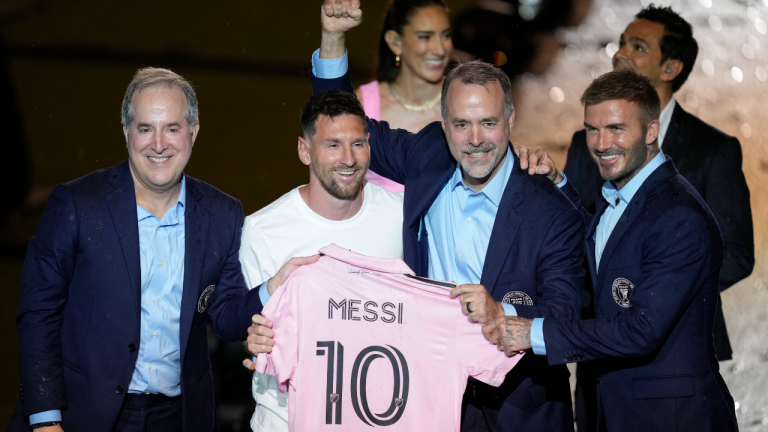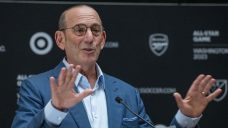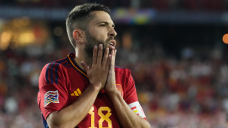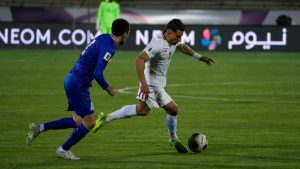After years of speculation linking Lionel Messi to a move to the United States, the Argentine icon shocked the sporting world by turning rumour into reality and officially joined Inter Miami in June, and the former Barcelona legend is set to play his first match as an MLS player on Friday.
The 36-year-old’s debut, set for a Leagues Cup match between Miami and Liga MX side Cruz Azul, comes after a raucous event Sunday in which the seven-time Ballon d’Or winner was officially introduced to fans at Miami’s DRV PNK Stadium. A sold-out crowd watched Messi take the stage, embrace fellow European-star-turned-American-talisman David Beckham, co-owner of the club, and hold aloft his new No. 10 jersey.
The evening was the culmination of what’s been a rollercoaster journey for the MLS side since Messi announced he was coming. In the month-and-a-half since that decision, excitement throughout the city and the league has hit a fever pitch. Messi’s impact was felt even before he arrived in town, his new club’s Instagram follower count skyrocketing, jumping from 1 million to 10.5 million, more than any other American pro sports franchise. Ticket prices have soared too, and though the club’s attendance was among the lowest in MLS last season, it packed nearly 20,000 fans into seats — in the pouring rain — just to witness Messi stroll out onto a stage.
It's a landmark moment for the club, for the league and for the sport in North America at large, a move that could significantly alter the soccer landscape on this side of the world. Because while other international superstars of the sport have touched down in North America before, Messi’s move to Miami is on a different level than anything we’ve ever seen on this side of the Atlantic.
To get a better sense of just how novel a situation it is, and just how significant his impact could be, we took a look back at some of the most prominent past arrivals of global soccer talents in America.
PELE GIVES THE COSMOS A TRUE STAR
Perhaps the most comparable situation is the first one, the arrival of Pele in New York in 1975.
The Brazilian hero was nearly the same age Messi is now when he signed with the New York Cosmos, having won a trio of World Cups, dominated for nearly two decades with his club team, Santos, and established himself as a generational, otherworldly talent. There was of course no Major League Soccer back then — Pele’s American tour came for the North American Soccer League. A packed stadium of 21,000 saw the Brazilian’s debut, seven times the club’s average attendance from the season prior.
By the time he’d finished his third and final season with the Cosmos — in an exhibition match against Santos, in front of 75,000 fans at Giants Stadium — attendance had soared, millions were tuning in to watch matches on TV, too, and the perception of the sport in the U.S. had shifted.
Still, while Pele’s presence brought unprecedented relevance to soccer in the U.S., and lured other stars to the NASL, the sport was still too new to the country at that time to keep hold of that momentum. In 1985, a decade after Pele had arrived, the NASL folded.
BECKHAM BRINGS THE SPOTLIGHT TO HOLLYWOOD
For MLS, the beginning of the era of elder superstars journeying to the U.S. began in 2007, when David Beckham orchestrated an unexpected move of his own, leaving Spanish giant Real Madrid for a lucrative deal with L.A. Galaxy.
It was, similarly, an unprecedented decision, MLS seen then as an unserious league, not long removed from bankruptcy worries, still unproven. Born the year Pele went to New York, Beckham was in his early ‘30s himself when he made his move to L.A., and by then a global superstar following a wildly successful run with Manchester United and a more tumultuous tenure as part of a star-studded cast at Real Madrid. The Englishman was far from conversations about the world’s best, but he was undeniably one of the most famous athletes in the world, and his arrival in California brought with it a level of international attention MLS had never seen.
Beckham’s move to MLS altered the league logistically, too, his addition prompting the creation of the Designated Player Rule — originally nicknamed the Beckham Rule — allowing MLS teams to bypass the salary cap to bring in marquee talents, paving the way for a string of fellow European stars to make the jump to the U.S. in the years that followed.
VETERAN ICONS SET SIGHTS ON MLS
In the decade-and-a-half since Beckham went over, opening that door to MLS, hundreds of designated players have dotted the league’s rosters, highlighted by a number of particularly notable legends of the game:
2010: Henry signs with New York Red Bulls
Thierry Henry signed with New York, just a year removed from a banner season in Barcelona that had seen him collect six trophies with the Spanish side. That stint, of course, came after an iconic career with Arsenal that established Henry as one of the greatest strikers of all time. Over five years and 122 appearances in New York, the Frenchman amassed 51 goals, twice helping the club finish atop its conference, and — unlike many of the other veteran stars who would follow him to MLS — captaining the side to a Supporters’ Shield in his fourth American season.
2014: Kaka joins Orlando City, Villa joins NYC FC
A few years and more arrivals down the line, 2014 saw the addition of another pair of legends in Kaka and David Villa. The former landed in Orlando City with a well-established penchant for winning, the Ballon d’Or recipient having conquered the World Cup, the Champions League, Serie A and La Liga over his tenures with AC Milan, Real Madrid and the Brazilian national team. The inventive playmaker collected 24 goals and 21 assists over three seasons in Orlando, but was unable to lift the fledgling expansion club very far up the standings.
Villa joined New York City FC after more than decade in La Liga, similarly arriving as a World Cup champion, with a hefty trophy case from his stints with Barcelona and Valencia. He was, individually, just as dominant on this side of the Atlantic, collecting 77 goals over 117 matches in four seasons, and earning league MVP honours during his second season in New York. Finishing as his club’s top scorer in each of this four MLS seasons, Villa helped the expansion side climb into the upper echelon of MLS, his NYC FC finishing as the Supporters’ Shield runners-up in his third year with the team.
2015: Gerrard joins L.A. Galaxy, Pirlo and Lampard join NYC FC, Drogba joins CF Montreal
The next season saw another influx of renowned talent. On the West Coast, English star Steven Gerrard joined L.A. Galaxy after a legendary decades-long run with Liverpool, the former Reds skipper linking up with former teammate Robbie Keane, who’d signed with L.A. a few years earlier. The England international’s run in California was a brief one, Gerrard suiting up for 34 matches and tallying five goals in that span, while the club remained mired in the middle of the pack, league-wide.
Out east, Italian midfield maestro Andre Pirlo joined Villa in New York that same year, moving on from a sterling Serie A career that saw him amass 15 trophies for AC Milan and Juventus, while also claiming a World Cup with his national side. Through 60 appearances for NYC FC, Pirlo managed 11 assists, teaming up with Villa and fellow European transplant Frank Lampard, who’d joined NYC FC after a run of greatness with Chelsea that left his trophy case similarly well-stocked. The Supporters’ Shield runners-up campaign in New York wound up being the last of Pirlo’s career.
Didier Drogba made the jump to North America the same season, signing with CF Montreal (then known as Montreal Impact) after stints in China and Turkey — and a brief return to Stamford Bridge — that followed his initial dominant run with Chelsea alongside Lampard. The lethal striker collected 21 goals in 33 games for Montreal, but overall the team enjoyed little success. Drogba finished out his career playing a couple years in Arizona with the United Soccer League’s Phoenix Rising following that spell in Montreal.
2017: Schweinsteiger joins Chicago Fire
Just a few years removed from helping his national side lift the World Cup and his club team win the Champions League, German legend Bastian Schweinsteiger made the move to MLS’ Chicago Fire from Manchester United in 2017, ending a two-year stint in England that had followed a dominant 13-year run with Bayern Munich. The Bundesliga Hall of Famer had 10 assists and eight goals during his three seasons in Chicago, helping the club finish third in the league in their inaugural year, before they tumbled back down over his next two years Stateside.
2018: Zlatan joins LA Galaxy, Rooney joins DC United
The 2018 season saw the arrival of two of the most entertaining European transplants since the creation of the Designated Player Rule, as Swedish character Zlatan Ibrahimovic signed with L.A. Galaxy and renowned English striker Wayne Rooney joined DC United.
Ibrahimovic’s journey west came after a tour through seven of the most well-known clubs in the world — Manchester United, Paris St. Germain, AC Milan, Barcelona, Inter Milan, Juventus and Ajax. The acrobatic goal-scorer had an immediate impact in California, netting a pair of goals in his debut and 20 more by the season’s end. He finished with a wild 52 goals in 56 matches, though the club enjoyed minimal success over those two seasons, before departing for another stint in Milan.
Generational scorer Rooney joined DC United after a brief spell at his boyhood club, Everton, which followed the conclusion of a 13-year run with Manchester United in which he stocked his trophy case with 16 titles. Rooney amassed 23 goals and 13 assists in 48 matches over his two years in DC. Still, like many of the other similar situations before, his new team struggled overall in that span. After two years in the U.S., Rooney returned to England to take on a player-coach role with Championship club Derby County.
MLS’ MESSI ERA
In that glimpse of the history of all-world overseas talents touching down in North America, you won’t find another situation like the one we’re seeing play out with Messi. Because although the Argentinian superstar brings a bit of what came with all of those past arrivals, he brings something else, too.
We’ve seen a decade-and-a-half of stars finishing their careers in MLS, marquee names who played out their final years in the league, caused a stir, but often didn’t upend much. But none who came had accomplished what Messi has, and none brought the level of overwhelming fame that follows the human highlight reel wherever he goes. To find any kind of real precedent, you have to rewind all the way back to those two original inflection points, Beckham in ’07, Pele before him, in ’75 — and even then, the link is tenuous, because Messi is stepping into an environment wholly unlike what Pele and Beckham experienced.
When Pele graced New York with his presence nearly five decades ago, North American soccer wasn’t yet ready to capitalize on his greatness. The sport was too young on this continent, the infrastructure still in its early stages. Though his impact was felt, there was still much growth needed — leagues folding, others emerging, a culture slowly building.
When Beckham came to North America in ‘07, it wasn’t so dissimilar. MLS then was less than a decade removed from bankruptcy worries, and still years away from the influx of talent that would come later. In the Englishman, the league found a lightning rod for international attention, a reason for the world to look in MLS’ direction. Still, when it came to what they’d see, much growth was needed. And Beckham, though one of the most famous athletes on the planet, was far from the type of dominant, otherworldly talent to take them there.
But Messi is the perfect storm.
He’s an icon who, like Pele, is held up as the greatest player in the world at this moment, undeniably one of the greatest to ever play the game, and only months removed from cementing his legacy with the whole world watching. And alongside that, courtesy of the Barca phenom’s rise coming in the age of social media, Messi brings the type of transcendent global fame Beckham once brought to MLS. Even more so, in fact — for frame of reference on the social media front, Beckham sits at 81 million followers on Instagram, Messi at a gargantuan 479 million.
But the most important distinction between this move to Miami and all the others that came before, is that Messi is bringing his divine skill to North America at a time when the continent seems ready for it. Unlike the environment Pele waded into, Messi arrives as MLS is peaking, the league fresh off a landmark $2.5-billion broadcast agreement with Apple a year ago. He arrives as interest in the sport is swelling in both the U.S. and Canada, both countries’ national sides excelling, and that swell expected to only continue growing over the next three years as we draw nearer to the 2026 World Cup, set to be held in 16 cities spread throughout North America, Miami among them.
The man himself is different, too — not arriving on his last legs, like some who came before him, but moving Stateside just months after authoring one of the most important moments of his career, on the sport’s biggest stage, and on the heels of a quality final European club campaign in Paris, too. He comes not because Miami was the greatest paycheque still out there for him, but rather the opposite, having spurned both lucrative offers in Saudi and a return to his beloved Barcelona. Even when it comes to the lack of team success we’ve often seen from star arrivals, Messi has given his new club a fighting chance, bringing with him former Barca teammates Sergio Busquets and Jordi Alba — perhaps soon Luis Suarez, too — all under the guidance of his former club and national team coach, Gerardo "Tata" Martino.
There are shades of the situation that feel familiar, given the names that have passed through MLS before. But taken all together — this player, in this league, at this time — nothing compares to what we’re about to see in Miami.
That new chapter begins Friday night.








COMMENTS
When submitting content, please abide by our submission guidelines, and avoid posting profanity, personal attacks or harassment. Should you violate our submissions guidelines, we reserve the right to remove your comments and block your account. Sportsnet reserves the right to close a story’s comment section at any time.